This set of Heat Transfer Operations Questions and Answers for Freshers focuses on “HT Equipment – Temperature Patterns in Multipass Heat Exchangers”.
1. Multipass Heat Exchangers classify heat exchangers on the basis of construction.
a) True
b) False
View Answer
Explanation: Multipass Heat exchanger classifies heat exchangers on the basis of number of flow passes or flow arrangements but not construction. If we talk about construction we can classify according to tubular, plate-type, extended surface and regenerative.
2. Which one of the following does not belong to the classes of multipass heat exchangers?
a) Compound flow extended surface
b) Regenerative
c) Split flow shell and tube
d) Parallel counter-flow shell and tube
View Answer
Explanation: Regenerative heat Exchangers are classification based on construction of the heat exchangers and not on flow pattern.
3. Which of the following is not a subset of Multipass Extended Surface Heat Exchangers?
a) Cross Counter Flow
b) Cross Parallel Flow
c) Split Flow
d) Compound Flow
View Answer
Explanation: A multipass extended surface heat exchanger can be classified according into three categories, they are Cross Counter flow, cross parallel flow and compound flow. Split flow is a category of multipass shell and tube HE.
4. How many Heat Exchangers can be classified on the basis of flow passes of the fluids?
a) 1
b) 2
c) 3
d) 4
View Answer
Explanation: For a heat exchanger to be classified on the basis of flow passage of participating fluids, they can be classified into Single pass and Multipass.
5. Which one of the following does not belong to Shell and tube heat exchangers?
a) Split Flow
b) Parallel counter-flow
c) Divided Flow
d) Compound Flow
View Answer
Explanation: A multipass shell and tube surface heat exchanger can be classified according into three categories, they are Split flow, Parallel counter-flow and Divided Flow. Compound flow is a category of Extended fins multipass HE.
6. Which one of the following statement is correct?
a) Split flow has one input flow and two output flow
b) Divided flow has two output flow and one input flow
c) Double split flow has two input flow and one output
d) Cross flow has two input and two output flows
View Answer
Explanation: Divided flow is the one that has two output passage and one input, whereas split flow and cross flow have single input and single output passages.
7. A double split shell and tube HE has two input and output flow passages respectively.
a) True
b) False
View Answer
Explanation: A double split shell and tube heat exchanger can be represented as the following in the diagram below.
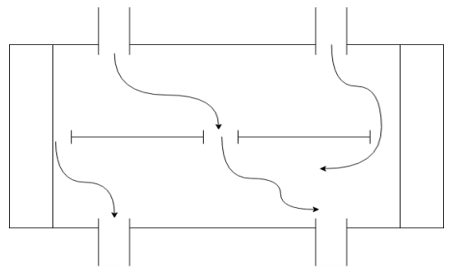
8. What is the name of the following setup?
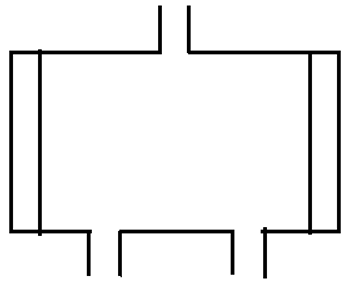
a) Cross flow
b) Divided flow
c) Split flow
d) Double split flow
View Answer
Explanation: The diagram represents a divided flow HE as it is to be noted that the shell has one input and two output units, which is the speciality of this HE.
9. In how many practical classes can we divide shell and tube HE based on the number of tube passes?
a) 2
b) 3
c) 4
d) 5
View Answer
Explanation: If we divide shell and tube HE based on the number of tube passes, we can divide it to 1-2, 2-4, and 3-6 shell and tube heat exchangers, i.e 3.
10. Which of the following statements are correct about the below heat exchanger?
NOTE: Cold fluid in tube and Hot fluid in the shell.
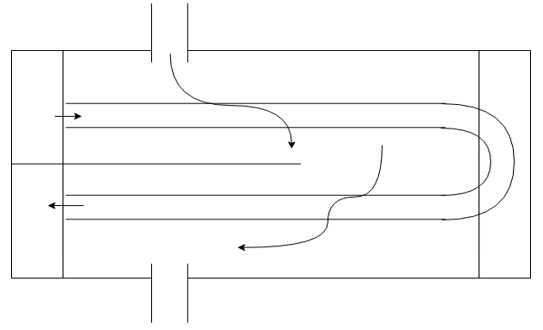
a) The temperature of the fluid in the tube monotonically decreases
b) The temperature of the fluid in the tube constantly increases
c) The temperature of the fluid in the tube reaches a maximum and then decreases
d) The temperature of the fluid in the tube reaches a maximum and then becomes constant
View Answer
Explanation: The cold fluid first comes directly in contact with the hot fluid, they exchange a large amount of heat in this region and the hot fluid in further contact with more cold fluid gets much cooler by the time the tube fluid returns to the shell in 2nd pass. Hence the temperature of the fluid in the tube reaches a maximum when it completes its 1st pass.
11. Recognize the below Multi-pass Heat exchanger.
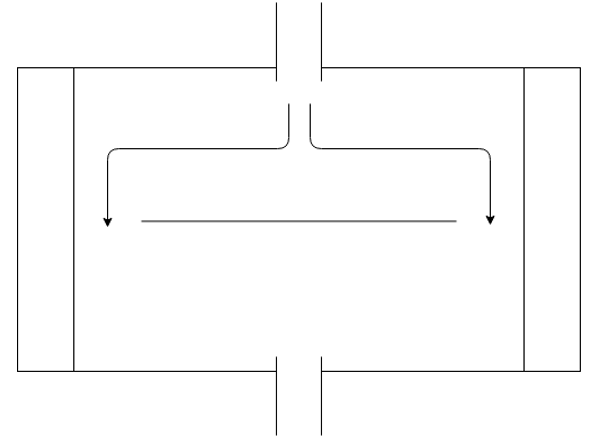
a) Cross flow
b) Divided flow
c) Split flow
d) Double split flow
View Answer
Explanation: A split flow HE has a longitudinal baffle at the centre of the shell and the two input units perpendicularly facing it. This setup helps proper mixing of the fluid in shell side so that tube fluid does not face any unnecessary ups and downs in temperature.
12. Which one of the following figures of equipments shows the following temperature profile of the heat exchanging fluids?
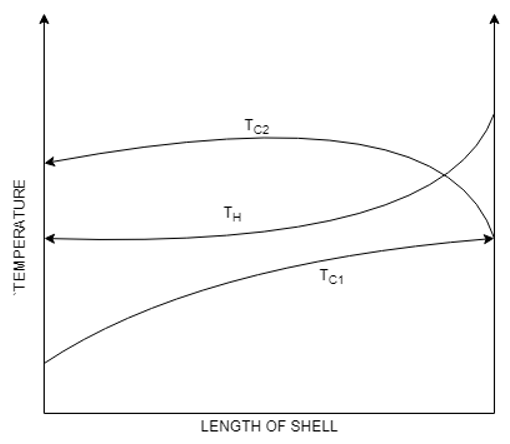
a) 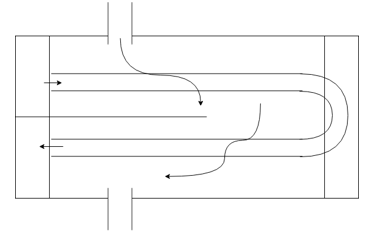
b) 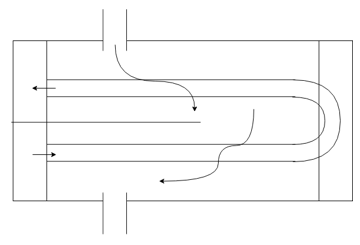
c) 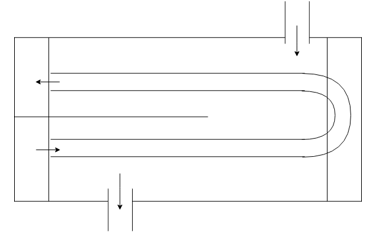
d) 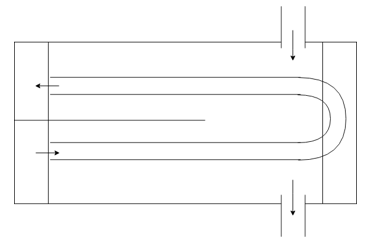
View Answer
Explanation: The cold fluid first comes directly in contact with the hot fluid, they exchange a large amount of heat in this region and the hot fluid in further contact with more cold fluid gets much cooler by the time the tube fluid returns to the shell in 2nd pass. Hence the temperature of the fluid in the tube reaches a maximum when it completes its 1st pass.
13. Which of the following statements are true about an m-shell n-tube Heat Exchanger?
a) It has m+1 shell partitions and n+1 tube passes
b) Temperature takes m-1 turns for shell and n-1 turns for tube
c) Temperature takes m+1 turns for shell and n+1 turns for tube
d) It has m-1 shell partitions and n-1 tube passes
View Answer
Explanation: In a m-n shell and tube HE, there are m shell compartments and n tube passes, for which we observe m-1_n-1 temperature elbows on the temperature length plot. Hence, if we look at the plot of temperature-length plot, we can very easily determine the type of the Heat exchanger.
14. Correctly select the temperature profile for the below setup.
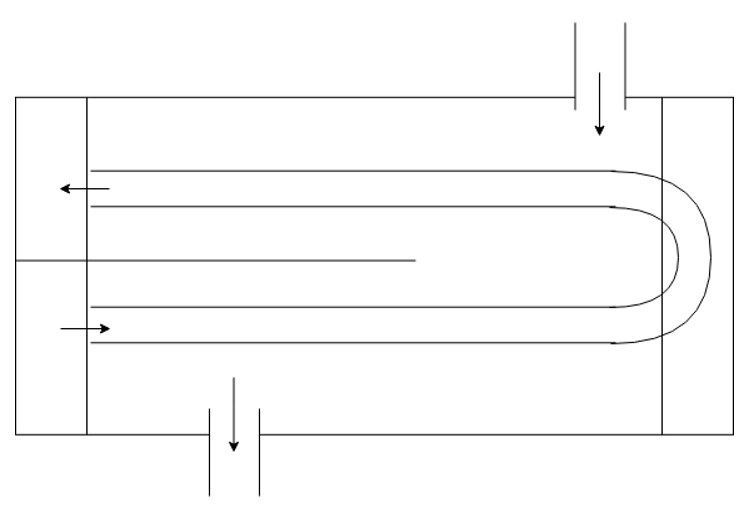
a) 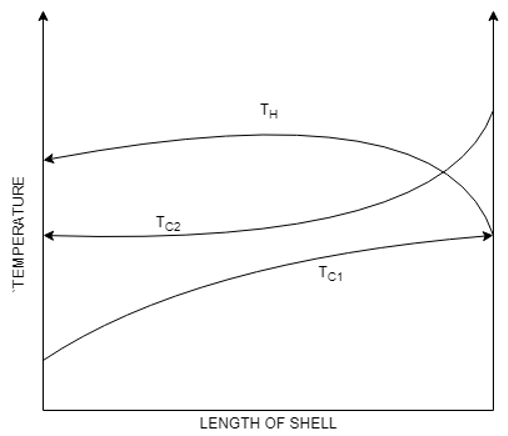
b) 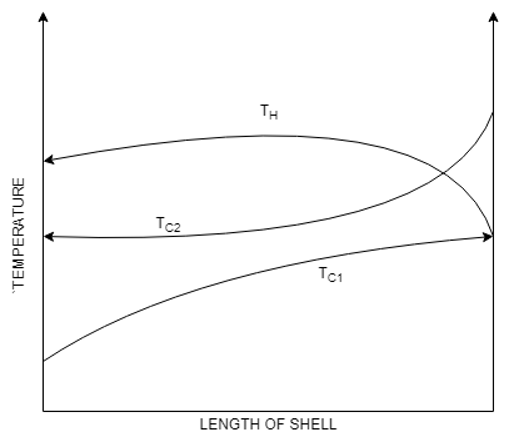
c) 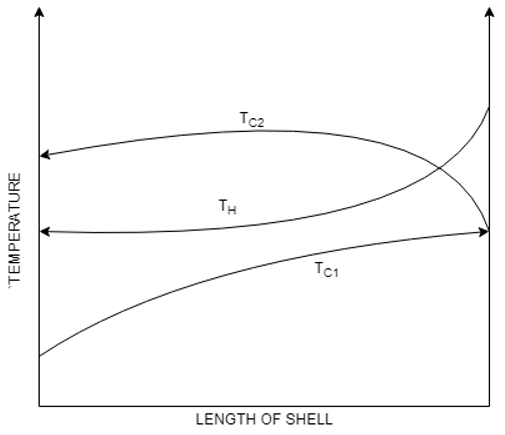
d) 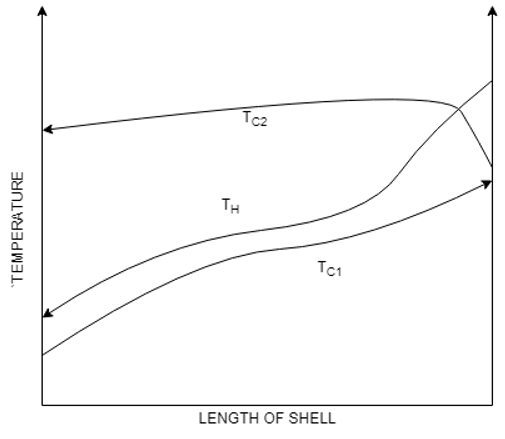
View Answer
Explanation: The cold fluid first comes contact with the exiting hot fluid, which has more or lost its heat energy, but they exchange a large amount of heat in the region where the tube fluid returns to the shell in 2nd pass. Hence the temperature of the fluid in the tube reaches a maximum when it completes its 1st pass and almost stays at that temperature.
Sanfoundry Global Education & Learning Series – Heat Transfer Operations.
To practice all areas of Heat Transfer Operations for Freshers, here is complete set of 1000+ Multiple Choice Questions and Answers.
If you find a mistake in question / option / answer, kindly take a screenshot and email to [email protected]
- Practice Chemical Engineering MCQs
- Check Heat Transfer Operations Books
- Check Chemical Engineering Books
- Apply for Chemical Engineering Internship
